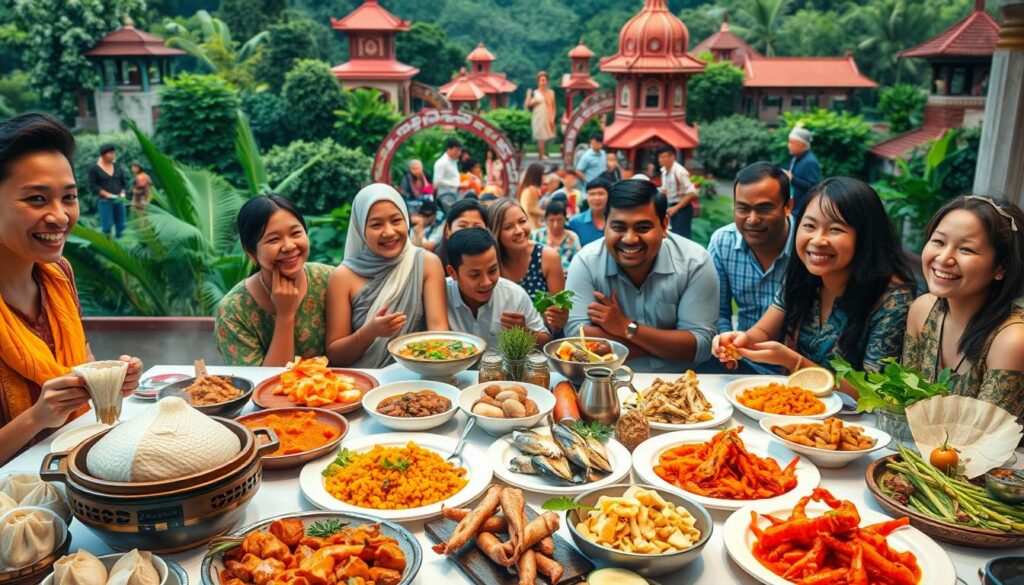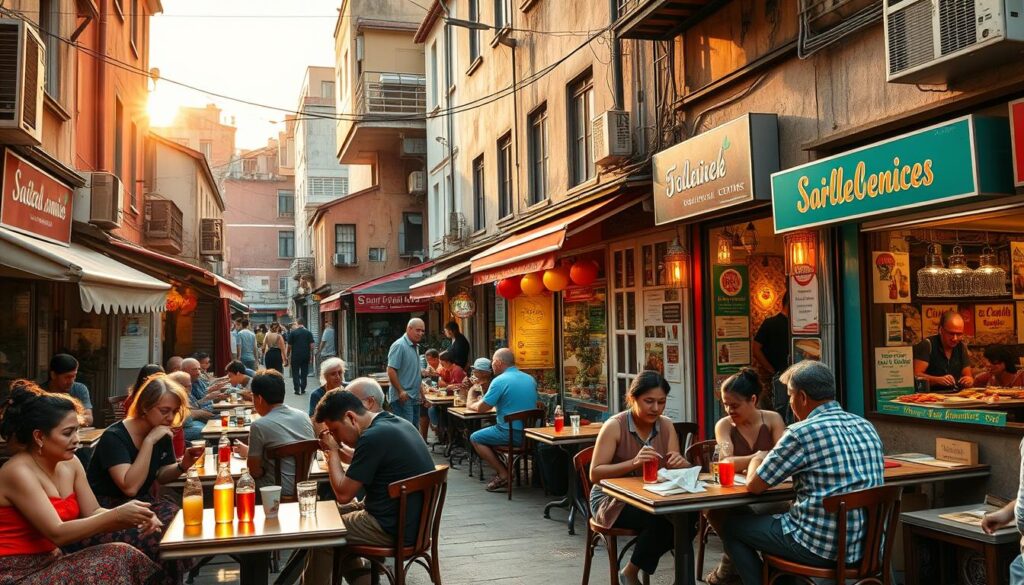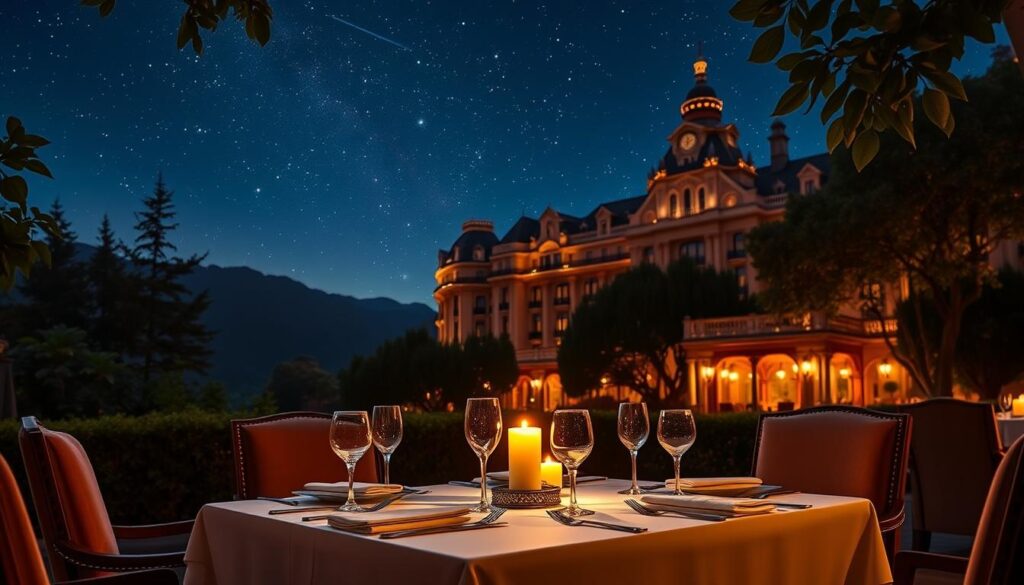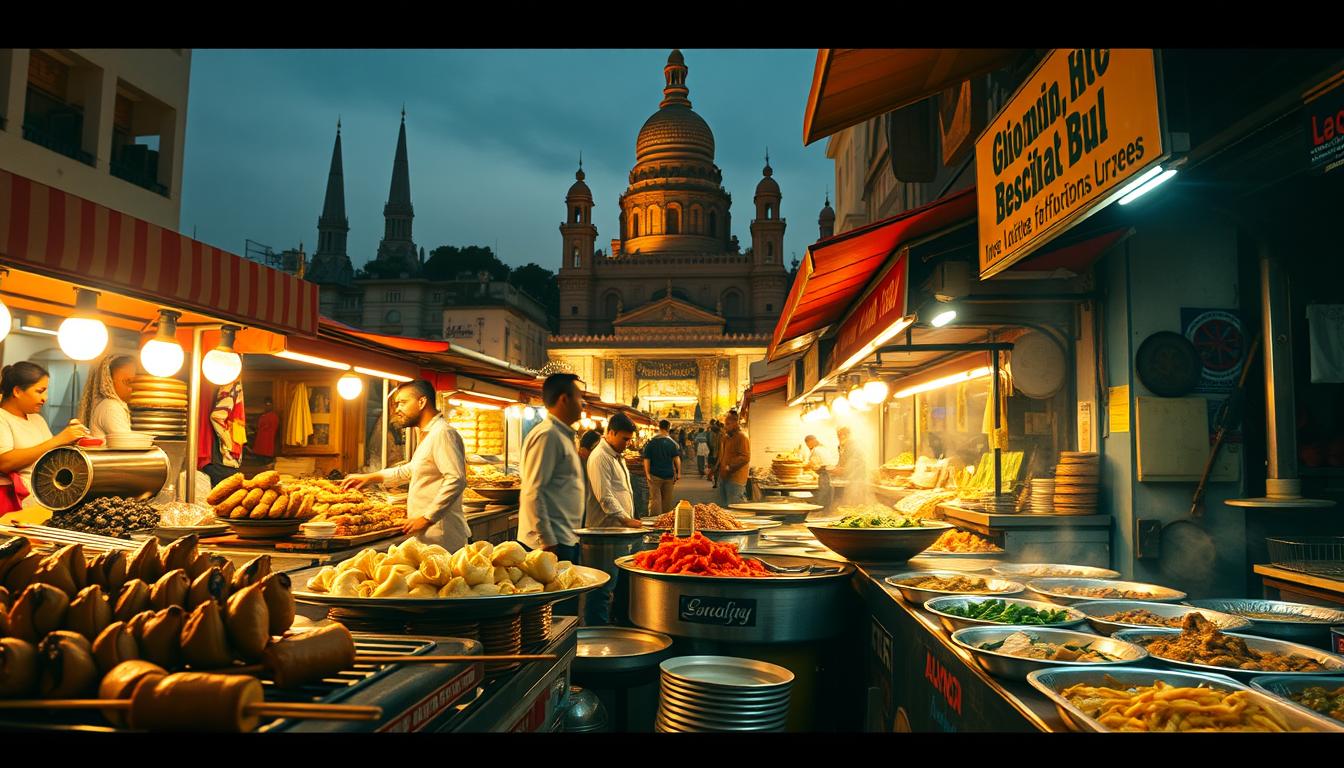Authentic Food Experiences Around the World
Did you know 88% of travelers say local cuisine directly influences their choice of destination? Taste isn’t just a sense—it’s a passport to understanding cultures, histories, and human connections that span continents.
Every bite tells a story. Picture savoring handmade dumplings in a family-run Beijing courtyard or learning age-old spice-blending techniques from a Marrakech chef. These moments turn meals into living memories, bridging gaps between visitors and communities.
From Tokyo’s midnight ramen stalls to vineyard feasts in Tuscany, culinary adventures redefine travel. They’re not just about eating—they’re hands-on journeys where you might harvest olives in Greece or share stories over chai in Mumbai.
Key Takeaways
- Local meals create deeper cultural connections than typical tourist activities
- Options range from street vendors to luxury dining with panoramic views
- Ingredients and recipes often reflect centuries of regional history
- Interactive experiences like cooking classes offer lasting skills
- Hidden culinary gems often exist far from guidebook recommendations
Ready to transform how you explore? This guide reveals how breaking bread with strangers can become your most treasured travel souvenir.
Introduction: Embracing Global Culinary Adventures

Breaking bread with strangers might be the ultimate cultural immersion. As Anthony Bourdain once said:
“Food is everything we are. It’s an extension of nationalist feeling, ethnic feeling, your personal history, your province, your region, your tribe, your grandma.”
Regional dishes act as edible history books. A single bite reveals how geography shaped ingredients, how trade routes influenced spices, and how generations perfected family recipes. This cultural education happens at market stalls where vendors explain heirloom produce, or in home kitchens where grandmothers teach rolling pasta by hand.
| Experience Type | Cultural Insight | Skill Gained |
|---|---|---|
| Street Food Tours | Daily rhythms & flavor preferences | Ordering etiquette |
| Market Visits | Seasonal ingredients & local economy | Bargaining techniques |
| Home Cooking Classes | Family traditions & meal rituals | Authentic preparation |
Modern travelers increasingly seek these living heritage moments. Over 60% now prioritize cooking workshops or farm visits alongside museum tours. Why? Kneading dough in a Sicilian bakery creates muscle memory no photo can match. Sharing tea with nomads teaches hospitality customs no guidebook explains.
These encounters reshape how we connect. A shared meal becomes a bridge—not just between taste buds, but between ways of life. Whether learning to fold dumplings in Shanghai or grind spices in Marrakech, every interaction leaves lasting imprints far richer than any souvenir.
Savoring Local Eateries from Street Food to Fine Dining

Local eateries serve as portals to a destination’s soul, one plate at a time. Take Cambodia’s Srey Kev market—a weathered wooden shack where servers wade into coastal waters to fetch crabs moments before they’re stir-fried with Kampot pepper. At under $5, this peppered crab feast proves unforgettable meals need neither white tablecloths nor hefty price tags.
Discovering Hidden Gems in Every Corner
The best culinary adventures begin where tourists hesitate to wander. A grandmother’s noodle cart tucked between Hanoi storefronts often outshines Michelin-starred spots. These unassuming places thrive on repetition—perfecting the same pho broth for decades or grilling satay skewers exactly as their parents taught.
Follow office workers during lunch hour. Their hurried orders at a Bangkok curry counter reveal trusted neighborhood staples. Locals know: plastic stools mean bold flavors and honest prices.
How Local Flavors Tell a Story
Every regional dish holds coded histories. That tang in your Oaxacan mole? Indigenous chocolate meets Spanish spices—a edible timeline of colonization. When a Tunisian cook explains harissa’s chili varieties, you’re learning about Saharan trade routes through your taste buds.
Family-run restaurants become living archives. In Lisbon’s Alfama district, bacalhau recipes passed through twelve generations turn salted cod into time machines. These flavor narratives transform meals from fuel to cultural compasses.
Epic Seafood Adventures by the Ocean

Oceanfront dining transforms meals into multisensory events where crashing waves and salt air become essential ingredients. Two establishments redefine coastal feasts through radically different approaches—one harnessing nature’s raw beauty, the other engineering aquatic wonderlands.
Kisik at Ayana Resort, Bali
Perched above Jimbaran Bay, Kisik turns dinner into a hands-on ritual. Guests select glistening seafood from ice beds—spiny lobsters, pearl oysters, tiger prawns—then watch chefs grill their picks over coconut husks. Sunset transforms the clifftop into a golden amphitheater, with grill smoke mingling with ocean spray.
Shark-Adjacent Dining at Burj Al Arab
Al Mahara’s aquarium restaurant makes marine life your dining companion. Silver trevallies dart past tables while sand tiger sharks patrol the curved glass walls. Though appetizers start at $300, the theatrical experience justifies the cost—waiters present lobster thermidor like museum curators unveiling art.
| Experience | Setting | Interaction | Price Range |
|---|---|---|---|
| Kisik | Open-air cliffside | Choose-your-own seafood | $$$ |
| Al Mahara | Underwater simulation | Aquarium immersion | $$$$$ |
Both restaurants prove location amplifies flavor. At Kisik, briny sea breezes enhance grilled squid’s char. In Dubai’s artificial lagoon, the aquarium’s blue glow makes champagne bubbles sparkle brighter. Whether natural or manufactured, these venues show how environment shapes our food memories.
For travelers seeking extraordinary meals, oceanside restaurants offer more than fresh catches—they serve plates layered with atmosphere, innovation, and storytelling. Just remember: waterproof shoes work better than heels on Bali’s rocky paths, while Dubai’s aquarium views pair best with platinum credit cards.
Desert Dining & Traditional BBQ in Cultural Landscapes

Imagine dining under a blanket of stars where flames lick underground ovens and centuries-old recipes come alive. Jordan’s Wadi Rum desert transforms meals into time capsules, preserving culinary practices unchanged for generations.
Zarb: Bedouin-Style BBQ in Jordan’s Wadi Rum
This ancient cooking method turns desert sand into a natural slow-cooker. Locals layer marinated lamb, root vegetables, and herbs in metal pots before burying them in smoldering pits. Four hours later, guests uncover tender meat infused with smoky whispers of juniper wood.
The ritual reflects Bedouin traditions of resourcefulness. As one tribal elder explains: “Our ancestors cooked this way to hide fires from rivals and conserve scarce water.” Today, sharing zarb fosters connection—travelers sit cross-legged on rugs while hosts demonstrate proper bread-dipping etiquette.
- Learn why underground pits lock in moisture better than modern ovens
- Discover how desert herbs like za’atar enhance flavors naturally
- Watch cooks use palm fronds as natural steam seals
After sunset feasts, Bedouin people often share stories around crackling fires. These moments reveal how nomadic cultures turned survival skills into celebratory dinner traditions. As embers fade, you’ll realize the true secret ingredient isn’t spice blends—it’s millennia of adaptation to Earth’s harshest landscapes.
Luxury Dining Under the Stars in Iconic Hotels

Iconic hotels transform dinner into celestial events where Michelin-starred plates meet starlit skies. These venues blend architectural marvels with gastronomic artistry, creating moments where every bite feels like a private conversation with the universe.
World-Class Experiences at Iconic Venues
At Porto’s Yeatman Hotel, Portugal’s wine legacy unfolds across a terraced hillside. The Michelin-starred restaurant pairs Douro Valley vintages with octopus carpaccio, while panoramic windows frame Vila Nova de Gaia’s riverfront. Sommeliers here don’t just pour drinks—they decode centuries of vitacultural heritage through rare Port blends.
Half a world away, Bangkok’s Lebua Hotel elevates dining literally and figuratively. Sirocco’s open-air deck floats 820 feet above neon-lit streets, a celestial place where lobster thermidor arrives as fireworks explode over the Chao Phraya River. It’s dinner theater meets engineering marvel.
- Yeatman’s wine-themed menus change with lunar cycles
- Sirocco’s mixologists craft cocktails at cloud level
- Both venues use elevation to amplify sensory impact
Premium pricing reflects more than truffle shavings—it buys exclusivity. At these heights, every champagne bubble pops brighter. Every star seems closer. You’re not just eating; you’re claiming a sliver of sky normally reserved for satellites and daydreams.
Sunset Dining on Picturesque Island Retreats

What transforms a meal into magic? When golden-hour light dances across your plate while ocean breezes carry citrus notes from nearby groves. Island sunset dining blends nature’s spectacle with culinary craftsmanship, creating evenings where every sense engages.
Belvedere in Mykonos: Sunset and Sophistication
At Belvedere Hotel’s rooftop perch, day becomes night in a liquid amber haze. Mixologists shake lychee caipiroskas as the sun dips behind whitewashed buildings. This dining hotspot proves Instagram backdrops can coexist with substance—especially when Chef Nobu Matsuhisa’s kitchen delivers Japanese-Peruvian ceviche with Aegean flair.
The evening unfolds like a well-choreographed show. Guests time their first bite to match the sky’s transition from peach to violet. Local octopus meets yuzu kosho paste, challenging taste buds to reconcile Cycladic traditions with Tokyo’s precision.
Mykonos’ “never sleeps” reputation gets a gourmet makeover here. Between courses, whispers of bougainvillea mix with clinking glasses from neighboring tables. It’s where jet-setters and locals bond over shared amazement—both at the chef’s creations and nature’s nightly masterpiece.
Adventurous Meals: Land, Sea, and Air
Altitude adds unexpected flavor to modern journeys. Airlines now transform cramped seats into culinary stages, proving memorable meals aren’t confined to ground level.
In-Flight Surprises with Air New Zealand
Their economy class shatters expectations. On London-Los Angeles routes, passengers savor chickpea quinoa salads and curried veggie mains—dishes showcasing New Zealand’s farm-fresh ethos. Even dessert gets inventive: honeycomb ice cream drizzled with local manuka honey.
En Route Indulgence with Emirates
Business class takes luxury airborne. Lobster tail replaces standard airplane food, served alongside vintage champagne. The real magic happens at 40,000 feet: a social lounge lets travelers mingle over mezze platters during 15-hour flights.
These innovations redefine travel things we tolerate. What was once a bland necessity becomes a way to taste destinations before landing. From eco-conscious economy menus to sky-high cocktail bars, every bite midair now hints at adventures ahead.
FAQ
How can I find authentic local eateries while traveling?
What makes oceanfront dining experiences unique?
How does desert dining enhance cultural exploration?
Can luxury hotels offer genuine local cuisine?
Are adventurous dining experiences worth trying?
What’s the best way to enjoy sunset dining?
How do meals reflect a destination’s history?

Sharon Molly is a content creator in lifestyle, fashion, and travel, delivering style-savvy advice and destination insights to inspire confident living. With a background in digital media, she combines aesthetics with practical guidance for modern women on the go.




